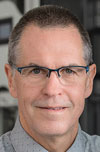
Market researchers at the International Data Corporation predict that humans and machines could generate 175 zettabytes of data by 2025. If this amount of data were stored on conventional DVDs, it would equate to 23 stacks of data discs, each of them reaching to the moon.

Adrian Buddingh, managing director for Rittal South Africa, says that an estimated annual growth rate of 27% will place major pressure on company infrastructure: “Storing this amount of data will prove costly and based on this, we are seeing an obvious trend in companies migrating towards the use of cloud technologies. While cloud technologies are now common practice overseas, the adoption rate locally has been slow but steady.”
A survey published earlier this year by Germany’s Bitkom ICT industry association showed that three out of four companies are already using cloud solutions: Buddingh notes a concern in this regard: “Businesses making use of cloud solutions from third-party providers tend to lose some control over their corporate data. That is why, for example, the US Cloud Act (Clarifying Lawful Overseas Use of Data) allows US authorities to access data stored in the cloud, even if local laws at the location prohibit this.”
According to Buddingh, future success in business will only be sustainable if businesses keep pace with full digital transformation and integration: “Companies should use their data more and more to provide added value in real-time. Retaining control over data is becoming a critical success factor for international competitiveness.”
Trend 1: Data control
The self-determined handling of data is becoming a key competitive factor for companies. “This applies to every industry in which data security is a top priority and where the analysis of this data is a key factor for business success,” explains Buddingh. “Examples are the healthcare, mobility, banking and manufacturing industries. Users are now faced with questions around how to process their data securely and efficiently, and whether to modernise their own data centre, invest in edge infrastructures, or use the cloud.”
Smaller data centres with open cloud stacks might be able to create a new class of industrial applications that perform initial data analysis at the point where the data is created and use the cloud for downstream analysis.
Trend 2: Standardisation in data centres with OCP
The rapid upgrade of existing data centres is becoming increasingly important for companies, as the volume of data needing to be processed continues to surge. Essential requirements for this growth are standardised technology, cost-efficient operation and a high level of infrastructure scalability.
“The OCP technology (open computer project) with its central direct current distribution in the IT rack is becoming an interesting alternative for more and more CIOs,” says Buddingh. “This is because DC components open up new potentials for cost optimisation. For instance, all the IT components can be powered centrally. This way, efficient cooling is achieved since fewer power packs are present. At the same time, the high degree of standardisation of OCP components simplifies both maintenance and spare parts management. The mean efficiency gain is around 5% of the total consumed current.”
Rittal expects that OCP will establish itself further in the data centre as an integrated system platform in 2020. New OCP products for rack cooling, power supply or monitoring will enable rapid expansion with DC components. Furthermore, new products will support the conventional concept of a central emergency power supply, where the power is safeguarded by a central UPS.”
Trend 3: Heat recovery and direct CPU cooling
Data centres release huge amounts of waste heat into the environment. As the power density in the data centre grows, so too do the amounts of heat, which can then potentially be used for other purposes. So far, however, the use of waste heat has proven too expensive, because consumers are rarely found in the direct vicinity of the site, for example. In addition, waste heat, as generated by air-based IT cooling systems, is at too low a temperature (40°C) to be used economically.
“In the area of high-performance computing (HPC) in particular, IT racks generate high thermal loads, often in excess of 50 kW,” explains Buddingh. “For HPC, direct processor cooling with water is significantly more efficient than air cooling, so that return temperatures of 60-65°C become available. At these temperatures, for instance, it is possible to heat domestic hot water or feed heat into a district network.”
Trend 4: Integration of multi-cloud environments
“Businesses need to be assured that they can run their cloud applications on commonly used platforms and in any country. “This calls for a multi-cloud strategy,” concludes Buddingh. “From management’s point of view, this is a strategic decision based on the knowledge that its own organisation will develop into a fully digitised business.”
| Tel: | +27 11 609 8294 |
| Email: | [email protected] |
| www: | www.rittal.co.za |
| Articles: | More information and articles about Rittal |

© Technews Publishing (Pty) Ltd | All Rights Reserved